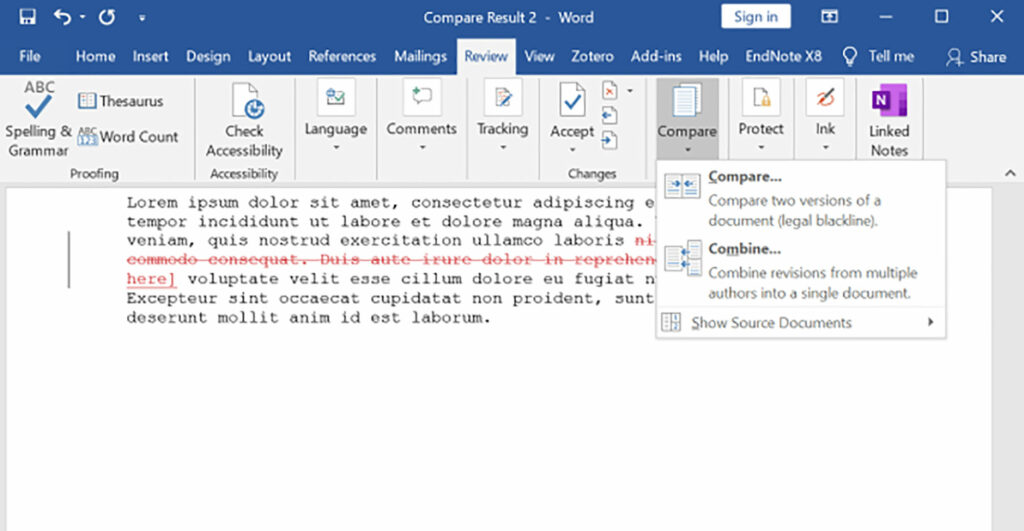Navigating Precision: A Comprehensive Guide on How to Compare Document Text Using Windows 10

Introduction:
In the dynamic realm of digital documents, the ability to compare text efficiently is paramount for professionals, students, and anyone dealing with multiple versions of written content. Windows 10, equipped with robust features, offers users a variety of methods to compare document text seamlessly. This comprehensive guide aims to unravel the intricacies of text comparison on Windows 10, providing a step-by-step exploration of built-in tools and external applications, empowering users to navigate the intricacies of textual revisions with precision.
Section 1: Built-in Text Comparison Tools
1. Word Document Comparison:
- Microsoft Word, a staple in the Office suite, boasts powerful built-in text comparison tools. Discover how to use the Track Changes feature to visualize and accept/reject edits, enabling a collaborative approach to document revision.
2. Notepad++ for Code Comparison:
- For users working with code or programming scripts, Notepad++ offers a feature-rich environment. Explore the Compare plugin to highlight differences between two code files, facilitating streamlined coding collaboration.
3. File Explorer Preview Pane:
- Windows 10’s File Explorer offers a quick preview of document content. Learn how to enable the Preview Pane and utilize it for a brief, side-by-side view of document text without opening files.
Section 2: External Text Comparison Software
1. Beyond Compare:
- Dive into the capabilities of Beyond Compare, an external software renowned for its text and file comparison functionalities. Uncover how to compare entire folders, files, and text snippets with precision.
2. WinMerge:
- WinMerge, an open-source tool, is designed for comparing and merging text files. Explore its intuitive interface and learn how to utilize its features for detailed text comparison and merging.
3. KDiff3:
- KDiff3, another free and open-source option, excels in three-way file comparison. Delve into its interface, understand how to use it for text merging, and navigate its powerful features.
Section 3: Online Text Comparison Tools
1. DiffChecker:
- DiffChecker, an online text comparison tool, simplifies the process for users who prefer a web-based solution. Discover how to upload, paste, and compare text instantly, with visual cues highlighting differences.
2. Text Compare by Small SEO Tools:
- Explore the user-friendly interface of Text Compare by Small SEO Tools. This online tool enables users to paste or upload text, generating a side-by-side comparison with color-coded differences.
3. Draftable:
- Draftable, a cloud-based comparison tool, offers a collaborative platform for comparing documents. Understand how to upload files, view visual comparisons, and collaborate seamlessly with others.
Section 4: Integrating Comparison into Workflows
1. Using Git for Version Control:
- Git, a version control system, allows users to track changes in code and documents. Learn how to utilize Git for version control, enabling collaborative editing while maintaining a detailed history of revisions.
2. Microsoft OneDrive Collaboration:
- Explore the collaboration features in Microsoft OneDrive, enabling real-time editing and version history tracking. Understand how to seamlessly collaborate on documents with colleagues or team members.
3. Google Docs Revision History:
- Google Docs, a popular cloud-based solution, offers an extensive revision history feature. Discover how to access and utilize this feature for tracking changes, comparing versions, and collaborating with others.
Section 5: Best Practices and Tips
1. Version Naming Conventions:
- Implement effective version naming conventions to organize document revisions systematically. This practice streamlines the comparison process and enhances overall document management.
2. Regularly Save Document Versions:
- Regularly save document versions to facilitate efficient text comparison. This ensures that you have a clear record of changes and can easily revert to previous versions when needed.
3. Document Metadata Considerations:
- Take into account document metadata, such as creation and modification dates, when comparing text. This metadata can provide valuable context when navigating through document versions.
Conclusion:
Mastering text comparison on Windows 10 involves understanding the intricacies of built-in tools, exploring external applications, and leveraging online solutions to streamline the revision process. Whether you’re collaborating on code, documents, or creative projects, the ability to compare text effectively is a skill that enhances productivity and precision. As you navigate the diverse landscape of text comparison tools, remember that the ultimate goal is to seamlessly manage and collaborate on document revisions while maintaining clarity and accuracy in your textual endeavors.





